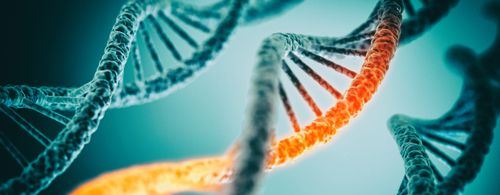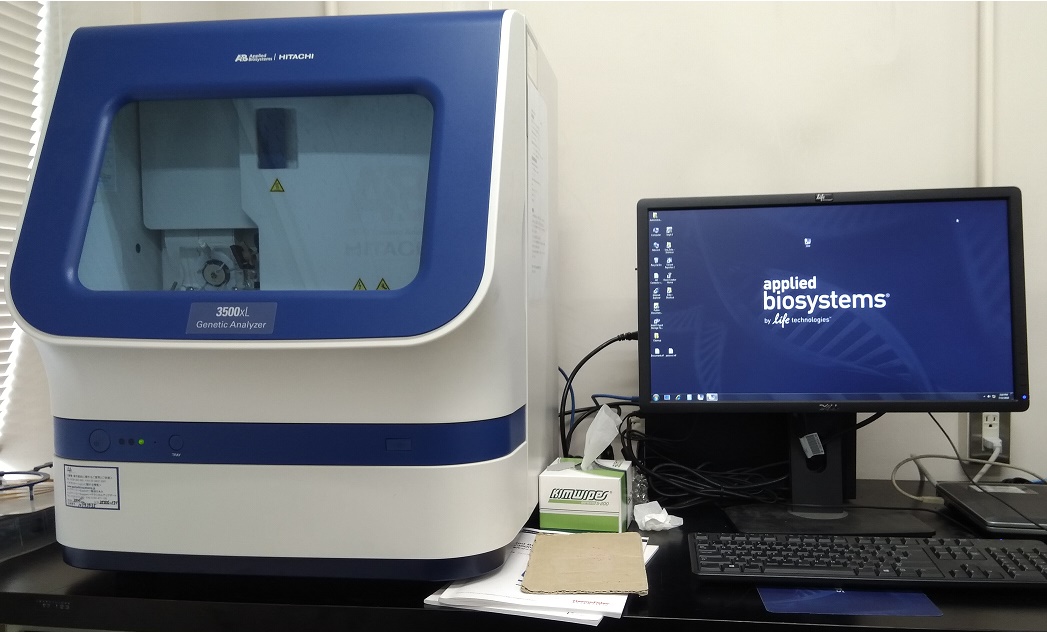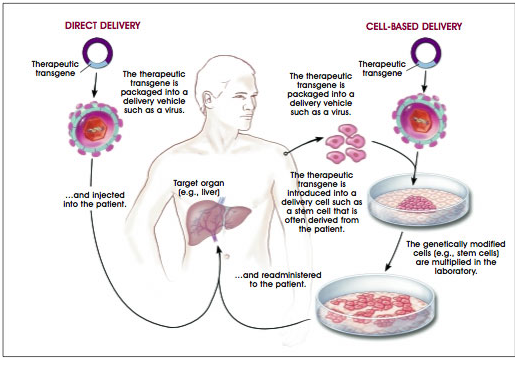Molecular biology is the study of the genetic makeup of organisms at the level of deoxyribonucleic acid (DNA). It encompasses the study of the ways in which diseases and traits can be passed through the genes especially via from parents to their offspring’s. Genes are the hereditary unit or genetic material that is transmitted from parents to their offspring’s and from one generation to another; and they are known to reside within the DNA of every living organism. The DNA is usually complexed or embedded with unique nuclear protein molecules known as histones; and they are structurally organized into chromatin-like structures known as chromosomes.
Chromosomes are rod-like structures located in the nucleus of every living organism, and which are mainly made up of DNA that carries the genes or genetic information of the cell/organism. The genetic information encoded by the genes or DNA are responsible for the synthesis of protein molecules with unique biological functions in the cell. The field of genetics blossomed as a branch of the biological sciences owing to the notable work of Gregor Mendel (1822-1884) who worked with garden pea plants (Pisum sativum) to determine how genetic materials are transmitted from parents to their offspring’s.
Genetics is simply defined as the study of genes and hereditary. Heredity is defined as the process in which genetic material (particularly DNA) is transferred from parents to their offspring’s. Genetics is generally the study of what genes are and their functions in living systems especially on how the DNA is replicated and passed on to the next generation. Genetics is generally the branch of biology that is concerned with the study of hereditary and variation or change that occurs in living organisms.
The most important objective of genetics is to understand the mechanisms behind the functioning and organization of genetic materials (genes) in living organisms. Genetics tries to understand the organization and functions of genes and/or DNA in living systems including man, animals, plants and microorganisms. The study of genes has transformed many areas of biological sciences especially in medicine, agriculture and biotechnology – where the knowledge of genes is being applied to develop goods and services beneficial to man and his environment.
DEFINITION OF TERMS IN MOLECULAR BIOLOGY
- Replicon: A replicon is the portion of the genome of an organism that contains the origin of replication. During DNA replication, the replicon is usually replicated as a unit.
- Single-stranded DNA binding proteins: Single-strandedDNA binding (SSBs) proteins are special type of protein molecules that bind the separated single strands of DNA molecules in order to keep it separated until the individual strands have been completely replicated. After the action of helicase enzyme on double stranded DNA molecule, the double strands unwinds and become single strands. But in order to remain separated so that the individual strands will be replicated, the SSBs bind the individual strands in order to keep them separated for DNA replication to start.
- Replication fork: The replication fork is the site on a double stranded circular DNA molecule where the double strands unwound for the replication of each of the separated single-strands. Synthesis of new DNA strand strands starts at the replication fork. During DNA replication or synthesis, two replication forks move around the double stranded circular DNA molecule and outwards from the origin of replication until the whole replicon have been duplicated or reproduced. The main function of the replication fork is that it generally helps the double strands of DNA molecule to separate for DNA replication or synthesis.
- Origin of replication: Origin of replication abbreviated as Ori is the particular site where DNA replication begins on a double stranded DNA molecule.
- Helicase: Helicase is the enzyme that unwinds double stranded DNA molecule prior to DNA replication. Helicase enzymes are primarily responsible for the separation or unwinding of the double stranded circular DNA molecule of microbial cells.
- DNA ligase: DNA ligase is a stitching enzyme that joins DNA fragments together. During DNA replication in bacterial cells, the lagging strands is usually synthesized discontinuously as short fragments known as Okazaki fragments which are later sealed or joined together by special type of enzymes generally known as DNA ligase. And the process of joining two or more DNA fragments together by the DNA ligase enzyme is known as ligation. DNA ligase is an important enzyme during gene cloning and other molecular biology techniques because the enzyme help molecular biologists to stitch or join cut DNA fragments together.
- Topoisomerase: Topoisomerases are enzymes produced by bacteria, and which removes or introduces negative supercoils to newly synthesized DNA molecules. They support the unwinding of double stranded DNA molecule. DNA gyrase is a typical example of a topoisomerase. Various types of topoisomerases are known to exist, and they include topoisomerase I, II and III. Topoisomerases also assist in the cleavage and rejoining of DNA fragments especially during DNA replication processes in bacterial cells.
- DNA gyrase enzyme: DNA gyrase enzyme is an enzyme that introduces negative supercoils into newly synthesized DNA molecules. They assist newly synthesized DNA molecules to assume their usual supercoiled double helix structure which is characteristic of bacterial genomic DNA.
- DNA polymerase: DNA polymerases are specialized enzymes with a variety of biological functions during DNA synthesis such as the synthesis of new DNA strands, proof-reading of gene sequence in the newly synthesized DNA strand, repairing and filling of gaps formed on the lagging strand during DNA replication, and the extension of DNA strands. Examples of DNA polymerase enzymes include DNA polymerase I, II and III.
- Nucleotide: A nucleotide is a nucleoside in which the sugar has one, two or more phosphate groups attached to it. Nucleotides are basic building blocks of nucleic acid molecules (i.e. DNA and RNA). Deoxyribonucleotides and ribonucleotides are typical examples of nucleotides. Purines (adenine and guanine) or pyrimidines (thymine and cytosine), pentose sugar and phosphate groups are the main components of a nucleotide.
- Okazaki fragment: Okazaki fragments are short pieces of DNA molecules produced during the replication of the lagging strand during DNA replication.
- Mutation: Mutation is defined as the alteration of the genetic information of an organism. After mutation, a new cell known as a mutant (with altered gene) will be produced. An alteration in the gene sequence of an organism or its genetic makeup (i.e. the genotype) leads to observable change known as phenotype in the organism. Molecular defects in the DNA can also be called mutation.
- Gene: Gene is a sequence of nucleotides in the nucleic acid molecule (DNA and RNA inclusive) of an organism which encodes the synthesis of unique protein molecules with specific biological function. A gene is a unit of DNA or chromosome which controls the synthesis of proteins; and genes also determine the phenotype of organisms. Genes are segments of DNA that code for specific functional products (e.g. proteins).
- Genome: Genome is the entire set of genes found in an organism.
- DNA: DNA is the acronym for deoxyribonucleic acid; and it is the main genetic material that is present in the nucleus of the cell.
- Chromosome: A chromosome is a chromatin-like structure comprising mainly of genes or DNA associated with histone proteins; and chromosomes carries the genes of the cell. They are found in the nucleus of the cell like the DNA and the genes.
- They are organized unit of genome or bundle of DNA wrapped in specialized type of proteins known as histones. The number of chromosomes in living organisms varies from one organism to another. For example, humans have 46 chromosomes (made up of 22 somatic cells and one sex-determinant chromosome); yeasts usually have 7 chromosomes while bacteria have only one. Eukaryotes usually have linear chromosomes while prokaryotes (e.g. bacteria) have circular chromosomes.
- Genotype: Genotype is simply defined as the total genetic makeup of an organism. It generally refers to the entire gene that encodes the characteristics of an individual organism. Genotype can also be known as the full set of paired genetic elements carried by each individual, and one which represents its genetic blueprint.
- Phenotype: Phenotype is the physical and observable characteristic of an organism. It is the observed outcome of gene expression in an organism. For example, a given gene sequence in the DNA of an organism codes for the synthesis of a particular protein molecule with specific biological function in the host organism. Only genes that are expressed contribute to the phenotype of the organism since not all genes are usually expressed during genetic transfer. Phenotype is generally the outward manifestation of the genotype; and it also includes an organism’s morphological, physiological and other physical behavioural attributes of the organism.
- RNA: RNA is the acronym for ribonucleic acid; and it is mainly responsible for translating genetic information as encoded by the DNA into specific proteins and enzymes in the cell. RNA is a nucleic acid like DNA.
- Protein: Proteins are macromolecules comprising mainly of amino acids; and they play critical biological roles in living systems such as for the repair of damaged tissues and also for growth.
References
Alberts B, Bray D, Johnson A, Lewis J, Raff M, Roberts K andWalter P (1998). Essential Cell Biology: An Introduction to the Molecular Biology of the Cell. Third edition. Garland Publishing Inc., New York.
Ausubel, F.M., Brent, R., Kingston, R.E., Moore, D.D., Seidman, J.G., Smith, J.A., Struhl, K., eds (2002). Short Protocols in Molecular Biology, 5th edn. John Wiley & Sons, New York.
Bains W (1998). Biotechnology: From A to Z. 2nd ed. Oxford University Press, New York, USA.
Branden C and Tooze J (1998). Introduction to protein structure. A non-technical introduction to protein structure. New York: Garland Press.
Chen I and Dubnau D (2004). DNA uptake during bacterial transformation. Nat. Rev. Microbiol. 2 (3): 241–249.
Cooper G.M and Hausman R.E (2004). The cell: A Molecular Approach. Third edition. ASM Press.
Dale J (2003). Molecular genetics of bacteria. Jeremy W. Dale and Simon Park (4th eds.). John Wiley & Sons Ltd, West Sussex, UK. Pp. 312-313.
Dale J (2003). Molecular genetics of bacteria. Jeremy W. Dale and Simon Park (4th eds.). John Wiley & Sons Ltd, West Sussex, UK. Pp.
Glick B.R and Pasternak J.J (2003). Molecular Biotechnology: Principles and Applications of Recombinant DNA. ASM Press, Washington DC, USA.
Hames B.D and Rickwood D (1998). Gel Electrophoresis of Proteins: A Practical Approach 3rd Edition. The Practical Approach Series, Oxford University Press
Latha C.D.S and Rao D.B (2007). Microbial Biotechnology. First edition. Discovery Publishing House (DPH), Darya Ganj, New Delhi, India.
Lewis R (2007). Human Genetics: Concepts and Applications. Seventh edition. McGraw-Hill Companies, Inc, New York, USA.
Lodish H, Berk A, Matsudaira P, Kaiser C.A, Kreiger M, Scott M.P, Zipursky S.L and Darnell J (2004). Molecular Cell Biology. Fifth edition. Scientific American Books, Freeman, New York, USA.
Madigan M.T., Martinko J.M., Dunlap P.V and Clark D.P (2009). Brock Biology of Microorganisms, 12th edition. Pearson Benjamin Cummings Inc, USA.
Tamarin Robert H (2002). Principles of Genetics. Seventh edition. Tata McGraw-Hill Publishing Co Ltd, Delhi.
Thieman W.J, Palladamo M.A and Thieman W (2003). Introduction to Biotechnology. Benjamin Cummings, San Francisco, CA.
Discover more from Microbiology Class
Subscribe to get the latest posts sent to your email.





